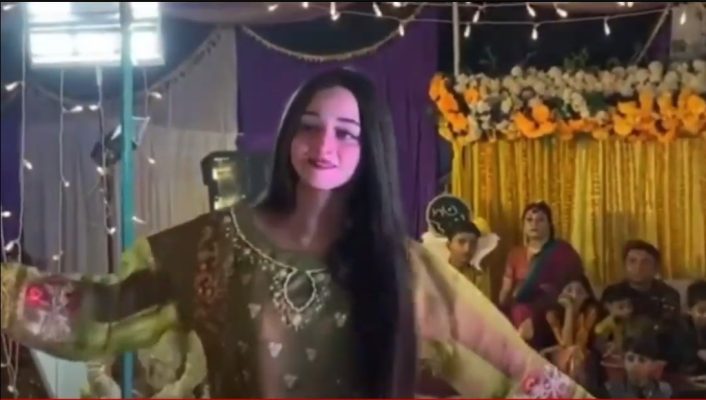
Intriguing audiences worldwide, the Ayesha Mano viral video has become a sensation, leaving netizens awe-struck. Unraveling its origin and captivating story, Nowviralvideo delve into the mesmerizing aspects that catapulted this video to unprecedented fame and the impact it’s having on social media.
Contents
The Viral Dance Video
Famed for her idiosyncratic footwork and animated demeanor, Ayesha Mano ascended to recognition through her widely circulated dance video to the melody “Mera Dil Ye Pukare Aaja”. Her renown surged to undreamt-of echelons when she regaled attendees at a matrimonial celebration in the waning days of October, spinning and twirling to a revamped version of Lata Mangeshkar’s timeless hymn “Mera Dil Yeh Pukare Aja”, executed in a novel manner. This spectacle promptly spread like wildfire across the digital landscape, amassing a multitude of spectatorial gazes and hurtling Ayesha into the unforgiving glare of stardom.
The Controversy
However, with fame comes scrutiny. Speculations about the existence of a private video of Mano spread like wildfire, causing a furore among her fans and followers. Despite the lack of concrete evidence, these rumors have impacted Mano’s reputation, with critics pointing to her choice of clothing and dance moves as reasons for the controversy. The alleged explicit video circulated widely on the internet, further fueling the controversy. It is worth mentioning that the authenticity of these videos remains unverified and they may be the result of fabricated content .

Ayesha Mano’s Response
Yet, renown invariably invites inspection. Rumblings concerning the presence of a clandestine recording featuring Mano proliferated at a blistering pace, inciting pandemonium among her ardent admirers and devotees. Notwithstanding the absence of incontrovertible proof, these murmurs have tarnished Mano’s standing, with detractors spotlighting her sartorial preferences and choreographic style as the seeds of the dispute. The purported salacious footage circulated rampantly in the digital sphere, stoking the already raging controversy. It is prudent to note that the legitimacy of these videos continues to be unauthenticated and might merely be the offspring of concocted material.
The “Ayesha Mano viral video” wielded a profound influence on social media within Pakistan, leaving a multifaceted impact that reverberated far and wide. The video, featuring Ayesha dancing to the tune of “Mera Dil Ye Pukare Aaja,” captured the attention of millions, elevating her to social media stardom and sparking broader discussions.
Firstly, the video’s soaring popularity helped propel TikTok to new heights in Pakistan. As one of the first viral sensations on the platform in the country, it served as a trailblazer, introducing TikTok to a wider audience and contributing to its rapid growth.
Conversely, the video also ignited a contentious debate surrounding the role of women in Pakistani society. Some critics deemed Ayesha’s dancing as overly provocative, invoking arguments about cultural norms and societal expectations. However, defenders of Ayesha countered, contending that she was merely expressing herself freely and that her dancing held no inherent harm.
In essence, the “Ayesha Mano viral video” wielded a dual impact on social media in Pakistan. On one hand, it played a pivotal role in popularizing TikTok, revolutionizing the social media landscape. On the other hand, it served as a catalyst for discussions about gender roles and societal expectations, encapsulating broader cultural dialogues.
The video’s impact extended beyond social media platforms, leading to Ayesha being featured in news articles and television shows, further enhancing her visibility and prominence. This heightened exposure consequently augmented her social media following, as more and more individuals sought to connect with and follow this viral sensation.
Indeed, the “Ayesha Mano viral video” epitomizes the potency of social media, transcending geographical boundaries and capturing the fascination of a global audience. Its ripple effects, spanning both technological trends and cultural reflections, continue to resonate within the fabric of Pakistan’s digital landscape. As discussions endure, the video’s impact is bound to endure as an enduring topic of contemplation and discourse.
Conclusion
Ayesha Mano’s narrative underscores the tribulations that individuals of public interest encounter in this era of online networking, wherein whispers multiply with lightning speed and reputations are susceptible to tremors. It’s crucial to harness discernment and lend credence to official declarations or authenticated origins to stave off unwarranted conjecture. As the dialogue encircling the “Ayesha Mano viral video” persists, the aspiration remains that verity will ultimately illuminate the murkiness, quelling the gossip and paving the way for Ayesha to proceed with her voyage in the dynamic social media sphere.

![[HOT] Watch Tyre Sampson Full Video on Reddit 4 [HOT] Watch Tyre Sampson Full Video on Reddit](https://nowviralvideo.com/wp-content/uploads/2023/09/tyre-sampson-full-video-390x220.jpg)

